No other country in the world can boast of a culture as rich and diverse as that of India. Centuries in the making, the vibrant and everlasting nature of her majestic heritage is seen in every nook and cranny of our great nation. The splendour of bygone eras is etched in every historical temple and mausoleum and is woven into the epic sagas passed down through generations, like those of the legendary Chola Kings.
An awe-inspiring epoch in Indian history is that of the ancient Chola Empire. Top 10s Only takes an in-depth look at this magnificent period in Indian history as we proudly list the Top 10 Greatest Chola Kings of Ancient India!
A Brief History Of The Chola Dynasty – Jewel Of Ancient India
The colossal power of the Chola Empire has always been an essential element of India’s glorious heritage. This was even before Kalki’s magnum opus, the epic Ponniyin Selvan books, enthralled generations of young bibliophiles, and even more recently, before watching the exploits of the legendary Chola kings in Mani Ratnam’s spectacular Ponniyin Selvan movie as it hit the screens across the globe!
The Cholas have the distinction of being the longest-ruling dynasty in the world. Their origins can be traced back to the Sangam Period of Ancient India, with prolific rulers like the Early Cholan king Karikalan, who has been credited with building the still-standing Kallanai dam or the Grand Anicut, in present-day Tamil Nadu.
After the glorious rule of the Early Cholan Kings, the power of the Chola Empire slowly receded into what is now called The Dark Age of The Cholas. There is no mention of the Chola heirs of this interregnum period (tentatively between c. 300 CE to c. 848 CE) or of their activities, apart from the fact that they managed to retain their ancient capital city Urayur.
However, the winds of change could be felt with the rise of the rival kingdoms of the Pallavas and the Pandyas in the 6th century and their subsequent battles for supremacy. Mid-9th century CE saw the re-emergence of the Cholas. This Medieval or Imperial Chola dynasty produced many dynamic leaders whose valiant efforts ultimately heralded the Golden Era of the Chola Empire.
If you are wondering who is the greatest Chola King, look no further. Top 10s Only is proud to create the stories and pictures of the best of these Medieval Chola kings, with their names boldly emblazoned in the Top Ten Chola rulers list!
Top 10 Greatest Imperial Chola Kings of Ancient India
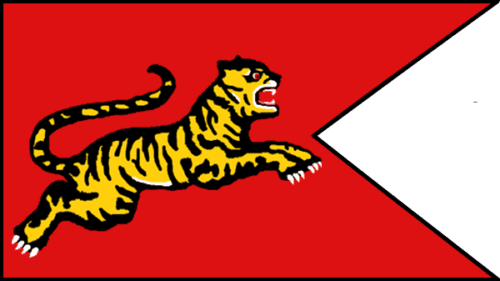
Here are the Top Ten Chola kings in chronological order.
1. Vijayalaya Cholan (847 CE – 871 CE)
2. Aditya Cholan I (871 CE – 907 CE)
3. Parantaka Cholan I (907 CE – 955 CE)
4. Parantaka Cholan II (962 CE – 980 CE)
5. Aditha Karikalan Cholan (966 CE – 971 CE)
6. Uttama Cholan (980 CE – 985 CE)
7. Rajaraja Cholan I / Arulmozhivarman (985 CE – 1014 CE)
8. Rajendra Cholan I (1014 CE – 1044 CE)
9. Rajadhiraja Cholan I (1044 CE – 1052 CE)
10. Virarajendra Cholan (1065 CE –1070 CE)
1. Vijayalaya Cholan (847 CE – 871 CE)
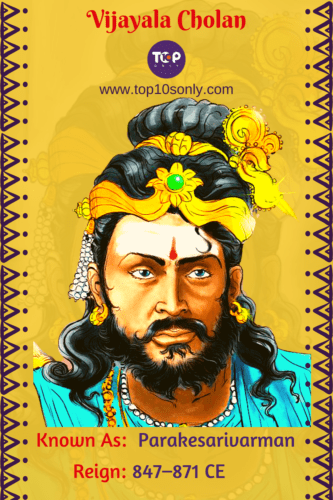
Vijayalaya Cholan
The second quarter of the ninth century saw the meteoric rise of a brave descendant of the Ancient Cholas, Vijayalaya Cholan. Believed to be initially a feudatory of the Pallava dynasty, his efforts succeeded in reviving the Chola empire from the obscurity into which it had faded.
Titles of Vijayalaya Cholan
Vijayalaya Cholan adopted the title of ‘Parakesarivarman’. Subsequent successors assumed the alternating titles of ‘Parakesarivarman’ and ‘Rajakesarivarman’ to acknowledge their legendary ancestors, Parakesari and Rajakesari.
Highlights of The Reign of Vijayalaya Cholan
Battle of Thanjavur
Vijayalaya Cholan’s rise to power started with the conquest of Thanjavur after his battle with Elango Mutharaiyar, the final ruler of the Mutharaiyar dynasty. The Tiruvalangadu plates state that Thanjavur was henceforth established as the capital of the rising Chola Empire. Vijayalaya Cholan is also believed to have won a crucial battle against the Pandya dynasty in the year 852 CE.
Administration of Vijayalaya Cholan
As per the inscriptions in the Tiruvalangadu plates, Vijayalaya Cholan is said to have built a beautiful temple dedicated to the goddess Nisumbhasudani Devi. He is also attributed to the expansion of the Vijayalaya Choleeswaram Temple in Narthamalai.
Personal Life of Vijayalaya Cholan
Historical records have not mentioned the details of any of the consorts of Vijayalaya Cholan. This great Chola King is believed to have passed away in c. 871 CE at Kalahasti (present-day Srikalahasti). He was succeeded by his sole heir, crown prince Aditya Cholan I.
Predecessor:
Suradhiraja Cholan

Vijayalaya Cholan
Successor:
Aditya Cholan I
2. Aditya Cholan I (871 CE – 907 CE)
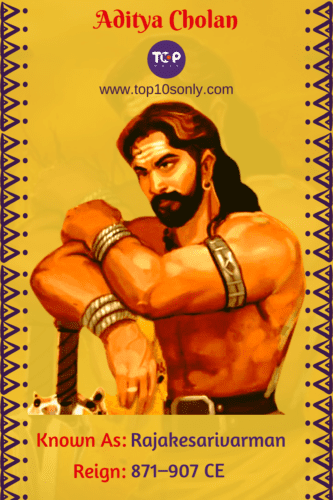
Aditya Cholan I
After the demise of Vijayalaya Cholan, the responsibility of consolidating and expanding the fledgling Chola Kingdom was passed on to his sole heir, crown prince Aditya Cholan I. He is credited with effectively ending the once-mighty Pallava empire. Aditya Cholan I strengthened the Chola Kingdom by conquering the Pallavas and occupying the Western Ganga Kingdom.
Titles of Aditya Cholan I
As per the tradition set by Vijayalaya Cholan for the Chola Kingdom Kings, Aditya Cholan I adopted the title of ‘Rajakesarivarman’. His conquest of Tondaimandalam earned him the title ‘Tondainadu-pavina Rajakesarivarman’ or alternatively ‘Thondainadu Kondaruliya’. The Kanyakumari inscription gives us the information that Aditya Cholan I was also known by the name Kodandarama.
Highlights of The Reign of Aditya Cholan I
Battle of Sri Purambiyam
One of the crucial events during the reign of Aditya Cholan I was the famous Battle of Sri Purambiyam, also known as the Battle of Thirupurambiyam, in 879 CE. It was this battle that hastened the decline of the Pandya and Pallava dynasties and cemented the supremacy of the Chola dynasty. Vijayalan Cholan’s annexation of Thanjavur had caused a power imbalance, which led the Pandyas to lose control of the areas lying north of the river Kaveri. To rectify this situation, the Pandyan King Varagunavarman II marched into the Chola territory Sri Purambiyam, or Thiruppurambiyam, in Thanjavur. However, his mission to reclaim his lost lands was foiled, as he was met with a formidable alliance of three powerful dynasties. Aditya Cholan I had aligned himself with the rulers of the Pallava and the Ganga kingdoms. The Pandyan army never stood a chance against such an indomitable force!
Battle at Tondaimandalam
To further strengthen the Chola Kingdom, Aditya Cholan I successfully invaded the Pallava Kingdom in c. 897 CE and killed Pallava King Aparajita, supposedly in a battle at Tondaimandalam (north Tamil Nadu). It is believed he earned the title ‘Tondainadu-pavina Rajakesarivarman’ ( The Rajakesarivarman who overran Tondainadu) after this battle.
Aditya Cholan I had succeeded in becoming the master of the Pallava, Ganga and Kongu Kingdoms. These victories achieved by Aditya Cholan I heralded the rise of an independent Chola Empire.
Administration of Aditya Cholan I
As per the Anbil plates of his descendent King Parantaka Cholan II (Sundara Cholan), Aditya Cholan I, an ardent devotee of Lord Shiva, is believed to have constructed innumerable Shiva temples along the banks of the Kaveri. The Nageswaraswamy Temple, in the city of Kumbakonam in the Thanjavur district of Tamil Nadu, was presumably constructed under his patronage. Neyyadiappar Temple in Thillaisthanam is also believed to have been built by King Aditya Cholan I, and many inscriptions have been attributed to him.
Personal Life of Aditya Cholan I
As per historical records, Aditya Cholan I is believed to have had two consorts – Tribhuvanamadeviyar (Vayiri Akkan) and Ilangon Pichchi. He had two sons, Parantaka Cholan I and Kannara Devan. Inscriptions state that Aditya Cholan I passed away in 907 CE at Tondaimanarrur, thus passing on the mantle to his heir, crown prince Parantaka Cholan l. In a few inscriptions, the Kodandaramesvara Temple has been referred to as Adityesvara Temple, and it is believed to have been a shrine or pallipadai built by Parantaka Cholan I, to honour his father, Aditya Cholan I.
Predecessor:
Vijayalaya Cholan

Aditya Cholan I
Successor:
Parantaka Cholan l
3. Parantaka Cholan I (907 CE – 955 CE)
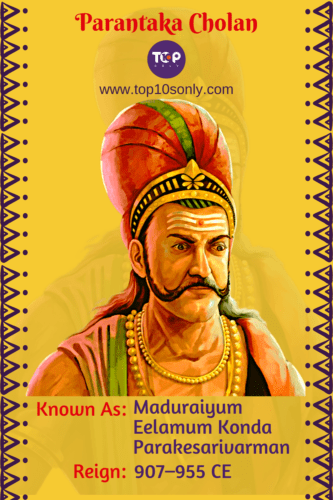
Parantaka Cholan I
Parantaka Cholan l’s ascension to power was not without its fair share of trouble. The first-born son of Aditya Cholan I had a clear claim to the vacant throne. However, not everyone was ready to accept this.
Born in 873 CE, he was the son of Queen Tribhuvanamadeviyar, presumably a princess from the Chera Dynasty. His half-brother was Kannara Devan, believed to have been a grandson of Rashtrakuta King Krishna II. The Rashtrakutas had been eyeing the Chola throne and had hoped to annex the Chola Kingdom by declaring Kannara Devan as the new Chola King. However, their dreams were foiled when, in 907 CE, the crown was placed on the head of the rightful heir – Parantaka Cholan l.
Despite this turbulent start, the reign of Parantaka Cholan I was filled with prosperity and lasted 48 years. He furthered the dream begun by his grandfather, Vijayalaya Cholan, and expanded the Chola Empire even more than his father, Aditya Cholan l.
Titles of Parantaka Cholan I
It is believed that he had also continued the legacy of adopting the alternating regal titles chosen by his grandfather Vijayalaya Cholan by adopting the title ‘Parakesarivarman’. During his tenure, he is believed to have earned several epithets, the notable ones being Veera-Chola, Veeranarayana, Chakravartin, Panditavatsalan, Irumadi-Sola (translated as the Chola who wears two crowns), and Surachulamani. His conquest of Madurai earned him the title ‘Madurakonda,’ and after his subsequent exploits in Sri Lanka, he was vested with the title ‘Maduraiyum Eelamum Konda Parakesarivarman‘ (with means The conqueror of Madurai and Lanka).
Highlights of The Reign of Parantaka Cholan I
Being a great military leader, Parantaka made extensive conquests up to Nellore in Andhra Pradesh. The reign of Parantaka Cholan saw many battles, the most notable ones being with the Pandya and the Rashtrakuta Dynasties.
Battle of Vellore and Aftermath
To strengthen the Chola Empire, Parantaka Cholan I set his sights on the kingdom of the Pandyas. Anticipating the attack, the Pandyan King Maravarman Rajasimha II formed an alliance with King Kassapa V of the Anuradhapura dynasty in Sri Lanka. However, even the combined armies of these two kingdoms were no match for the invasion of the Chola Empire in 910 CE. The Battle of Vellore commenced, and Madurai swiftly fell. To escape the Cholas, King Maravarman Rajasimha II went into exile and joined his allies in Sri Lanka. Parantaka Cholan I had decimated the Pandya Kingdom, and it became a part of the growing Chola Empire.
To complete his victory, Parantaka Cholan I desired to be coronated with the Pandyan Royal insignia and crown. However, these had been whisked away by the exiled Pandyan King and were safely stored in the vaults of the Anuradhapura Kingdom in Sri Lanka. Parantaka Cholan I then decided to boldly advance southwards towards Lanka. However, his invasion of Sri Lanka did not yield him the coveted Pandyan Royal Insignia, as it had been hidden away by King Kassapa V of Sri Lanka.
Battle of Takkolam – War Against The Rashtrakuta Clan
The Rashtrakutas invaded the Chola Kingdom in 916 CE. However, they were repulsed by the strong Chola army led by Parantaka Cholan I and his eldest son, Prince Rajaditya. For many years, the Cholas reaped the advantages of this successful conquest.
However, the war with the Rashtrakutas took a turn for the worse during the Battle of Takkolam, 948–949 CE. This intense confrontation changed the course of history for the Cholas, as they lost their crown prince, Rajaditya Cholan, during this battle. As per inscriptions, the Chola crown prince was struck by an arrow while seated atop his war elephant and died instantaneously. The Rashtrakutas were victorious.
The defeat at Takkolam undid decades of Chola Dynasty achievements made by Parantaka Chola I. It also paved the way for some of the most intriguing periods in the history of the Cholas, especially with regard to subsequent ascensions to the throne.
Administration of Parantaka Cholan I
Parantaka Cholan I is believed to have been a great administrator. His inscriptions show that he favoured many administrative reforms and even give a detailed account of the management of village assemblies. He promoted the creation of an excellent canal system that would benefit agricultural activities and prevent droughts. It is widely accepted that he was conferred the name ‘Thillaiyambalathhukku pon koorai veiyntha thevan‘ for providing the Thillai Nataraja Temple in Chidambaram with a golden roof.
Personal Life of Parantaka Cholan I
Parantaka Cholan I is believed to have had at least 11 wives, out of which two were princesses from the Chera Dynasty. He had four sons, Rajaditya Cholan, Gandaraditha Cholan, Uttamasili Cholan, and Arinjaya Cholan. Parantaka Cholan’s two daughters were Viramadevi and Anupama.
After his demise in 955 CE, his second son, Gandaraditha Cholan, ascended the throne.
Predecessor:
Aditya Cholan I

Parantaka Cholan I
Successor:
Gandaraditha Cholan
4. Parantaka Cholan II (962 CE – 980 CE)
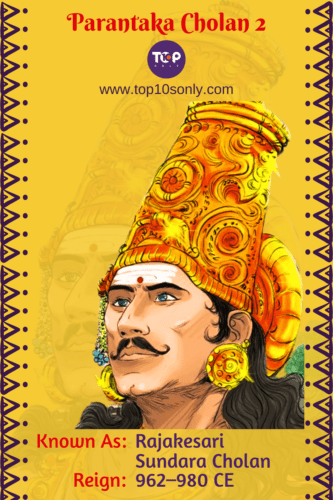
Parantaka Cholan II
Fans of Kalki’s Ponniyin Selvan novels are sure to recognise the significance of Sundara Cholan, the great Chola King Parantaka Cholan ll. Parantaka Cholan II had ascension issues almost similar to those that had plagued his namesake, his grandfather Parantaka Cholan l.
The untimely death of his uncle, the heir apparent Rajaditya Cholan, had led to his other uncle Gandaraditha Cholan ascending the throne. This uneventful rule lasted for approximately 12 years till Gandaraditha Cholan’s demise. Though the throne ought to have been rightfully passed on to his only son Uttama Cholan, it was his younger brother Arinjaya (Arikulakesari) Cholan, who was ultimately crowned King. Arinjaya Cholan seems to have also ruled the Chola Kingdom for a very short period of time till he passed away in c. 957 CE. Once again, Uttama Cholan’s claim to the throne was overlooked. Arinjaya Cholan’s son, Parantaka Cholan II, was crowned the new Chola King, despite the fact that his cousin Uttama Cholan had an equal, if not more, claim to the Chola throne.
By the time Parantaka Cholan II ascended the throne, the Chola Kingdom had lost most of its former glory. This was probably due to the lacklustre leadership of the two preceding Chola kings, Gandaraditha Cholan and Arinjaya Cholan. The Pandyas had made a comeback and had begun to occupy Chola territories. Even the Rashtrakutas had begun to exert control over Tondaimandalam. Trouble seemed to be brewing at all corners of the Chola Kingdom. However, Parantaka Cholan II seized control of his forces, and his subsequent efforts ensured that his descendants would have a strong and stable foundation upon which to rebuild the mighty Chola Empire.
Titles of Parantaka Cholan II
Parantaka Cholan II assumed the title of Rajakesari after ascending the throne. As he was quite handsome, he was also called Sundara Cholan. He assumed the epithets ‘Maduraikonda Rajakesari’ and ‘Madhurantaka’ after his conquest of Madurai.
Highlights of The Reign of Parantaka Cholan II
After ascending the throne, Parantaka Cholan II took stock of his kingdom. His immediate concern was the growing power of the Pandyas. King Veerapandiyan had successfully annexed many Chola territories. Thus, vanquishing the Pandya Dynasty became Parantaka Cholan’s primary objective after assuming power.
Battle of Chevur and Aftermath
After a period of meticulous planning, the Cholas, led by their King Parantaka Cholan II and his eldest son Aditha Karikalan Cholan I, invaded the Pandya Kingdom. The opposing forces met at a place called Chevur. This was an immensely gruesome battle, and it ended with the death of the Veerapandiyan. Even after this war, Parantaka Cholan II continued to conquer more parts of the Pandyan Kingdom. He is also believed to have fulfilled his grandfather’s unfulfilled wish by seizing the royal insignias of the Pandya Dynasty.
Expedition to Sri Lanka
The Sinhalese ruler of Sri Lanka, King Mahinda IV, was an ally of the Pandyas and had even sent a contingent to fight against the onslaught of the Cholas. Once the conquest of the Pandya Kingdom was completed, Parantaka Cholan II decided to invade Sri Lanka. However, this expedition was unsuccessful.
Administration of Parantaka Cholan II
The Chola Empire was set back on track by the administrative reforms initiated by both Parantaka Cholan II and his co-regent Aditha Karikalan Cholan I. A number of inscriptions give a comprehensive description of the reforms implemented in the military and navy, as well as in education and provincial administration. Sanskrit and Tamil literature flourished during his reign. Virasoliyam, a famous Buddhist book on Tamil Grammar, has references that prove he maintained friendly relationships with the Buddhists.
Personal Life of Parantaka Cholan II
Vanavan Madevi was the Queen consort of Parantaka Cholan ll, and together they had three children – Aditha Karikalan Cholan I, Kundavai Pirattiyar, and Rajaraja Cholan. The untimely death of his eldest son Aditha Karikalan Cholan I was a monumental tragedy from which the King never recovered, and he died in Kanchipuram in c. 980 CE. His demise earned him the epithet ‘Pon maligai thunjina thevar’ (the king who died in the golden palace).
Depiction of Parantaka Cholan II In Popular Culture
Sundara Chola is one of the main characters in Kalki Krishnamurthy’s Ponniyin Selvan books. He has also been portrayed in Mani Rathnam’s film Ponniyin Selvan: 1 by actor Prakash Raj.
Predecessor:
Arinjaya Cholan

Parantaka Cholan II
Successor:
Uttama Cholan
5. Aditha Karikalan Cholan (966 CE – 971 CE)
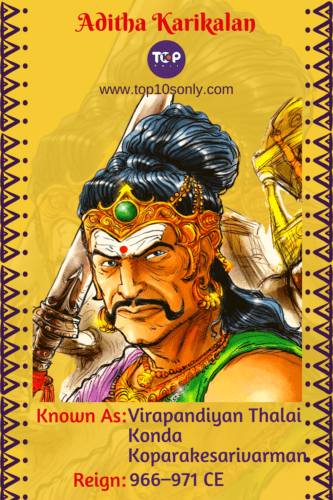
Aditha Karikalan Cholan
Yet another crucial character from Kalki’s novel Ponniyin Selvan, Aditya Karikalan, alternatively also known as Aditha Karikalan Cholan, was the eldest son and co-regent of the Chola Empire. A brave and worthy heir to the Chola throne, Aditha Karikalan Cholan was born in 942 CE. The heir apparent was groomed from a very early age to take on the mantle of the king that was presumably predestined for him. Unfortunately, fate had other plans for this brave warrior Chola prince.
Titles of Aditha Karikalan Cholan
Though not explicitly mentioned, it can be presumed that Aditha Karikalan Cholan would have been conferred the title ‘Parakesari’, as was the established tradition, had he been crowned King of the Cholas. However, he was called ‘Virapandiyan Thalai Konda Koparakesari Varman Karikalan‘ as he had effectively ended the brutal Battle of Chevur by beheading the Pandyan King Veerapandiyan.
Highlights of The Reign of Aditha Karikalan Cholan
Aditha Karikalan Cholan was co-regent for only a brief duration, approximately five to six years. However, his reign was quite eventful. It was filled with dramatic events that would, in the course of time, shape the destiny of the Chola Empire.
Battle of Chevur and Aftermath
Aditha Karikalan Cholan had ridden to battle alongside his father, King Parantaka Cholan ll. His military prowess, even at this young age, was outstanding, and it was his exceptional skills that ultimately led to the victory of the Cholas at the Battle of Chevur. The battle was brought to a gruesome end after he beheaded the Pandyan King Veerapandiyan.
Co-regent of the Chola Empire
Through his military and administrative skills, Aditha Karikalan Cholan proved himself to be a worthy bearer of the crown of the Chola Empire. This is probably what led to him being declared as co-regent of the Chola Empire, despite his Uncle Uttama Cholan having more claim to the throne.
Administration of Aditha Karikalan Cholan
Though the span of his co-regency was quite short, Crown Prince Aditha Karikalan Cholan seemed to have been a popular administrator of the Chola Kingdom. He had worked alongside his father, Parantaka Cholan ll, to implement various progressive reforms across the Chola lands.
Personal Life of Aditha Karikalan Cholan
One of the major events in Kalki’s books Ponniyin Selvan is Aditya Karikalan’s death. In 971 CE, heir apparent Aditha Karikalan Cholan was brutally assassinated by a group of conspirators who had plotted to avenge the death of the late Pandya ruler Veerapandiyan. Thus, the Chola Empire lost one of its most illustrious leaders. This was a great tragedy that had befallen the kingdom of the Cholas and left Parantaka Cholan II devastated till his death.
The Udaiyargudi inscriptions note that the chief conspirators were identified and punished during the 2nd year of the reign of the subsequent Chola ruler, King Rajaraja Cholan l.
Depiction of Aditha Karikalan Cholan In Popular Culture
Aditha Karikalan Cholan is one of the crucial characters depicted in Kalki’s Ponniyin Selvan novels.
Recently, the Aditha Karikalan Cholan character in Ponniyin Selvan 1 was flawlessly portrayed by Indian actor Vikram. His arch-enemy Veerapandiyan has been portrayed by actor Nassar.
In spite of being the main antagonist and love interest of Aditha Karikalan Cholan in the Ponniyin Selvan books and the movie, there is no historical reference to indicate the existence of Nandini in the Chola dynasty. The role of Nandini was portrayed by actor Aishwarya Rai Bachchan.
Predecessor:
Parantaka Cholan II

Aditha Karikalan Cholan
Successor:
Uttama Cholan
6. Uttama Cholan (980 CE – 985 CE)
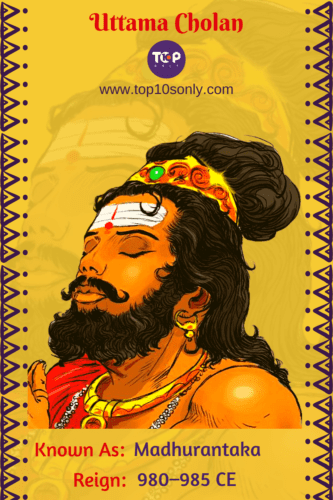
Uttama Cholan
In some ways, Uttama Cholan’s ascension to the Chola throne could be viewed as a meandering path towards the fulfilment of his ultimate destiny. The sole heir of King Gandaraditya Cholan, Uttama Cholan’s rightful claim to the throne was overlooked, and his uncle Arinjaya Cholan was crowned king instead. Even his hopes to succeed his uncle were shattered as the crown bypassed him and was instead bestowed upon his cousin, the eldest son of Arinjaya Cholan, Parantaka Cholan II.
Uttama Cholan was born as the only son of King Gandaraditya Cholan and his consort, the illustrious Queen Sembiyan Mahadevi. He seems to have been a small child at the time of his father’s demise, thus necessitating the need for a more capable Chola King to take control of the powerful Empire.
The mysterious assassination of Aditha Karikalan Cholan paved the way for Uttama Cholan’s ascension to power. After the demise of his cousin Parantaka Cholan II, Uttama Cholan was crowned king of the Chola Empire instead of Parantaka Cholan’s younger son Arulmozhivarman, alternately known as Rajaraja Cholan. It is believed that this was a clever tactic used by Arulmozhivarman to prevent the outbreak of civil war.
Titles of Uttama Cholan
The ‘Parakesari’ title was conferred to Uttama Cholan. He is known to also have the name ‘Gandan Madhurantakan’ or, alternatively, ‘Maduranthaka’.
Highlights of The Reign of Uttama Cholan
Uttama Cholan’s reign is believed to have been generally uneventful. From the information gleaned from his inscriptions, it seems he continued waging war against the Pandya dynasty and their allies in Sri Lanka.
He is credited with improving the condition of his army and providing his troops with armour waistcoats.
Administration of Uttama Cholan
Like his mother, Sembiyan Mahadevi, Uttama Cholan was very pious and was an ardent devotee of Lord Shiva. He is known to have donated generously to temples across the Chola Empire and even allocated grants to temples dedicated to the worship of Lord Vishnu. He codified the temple patterns, epigraphy, art, sculpture, and the keeping of administrative records. He also funded his mother’s pioneering work of Kalpani.
The second largest lake in Tamilnadu, the man-made Madurantakam Lake, is believed to be built by Uttama Cholan.
Personal Life of Uttama Cholan
Uttama Cholan is believed to have had several queen consorts, the notable ones being primary queen consort Sorabbaiyar Tribhuvana Mahadevi, Siddhavadavan Suttiyar, and Kaduvettigal Nandippottairaiyar. Uttama Cholan apparently had a son Madurantaka Gandaraditya. However, perhaps as part of a prior agreement with Parantaka Cholan ll, Uttama Cholan’s son never ascended the throne. Instead, the crown was passed on to Rajaraja Cholan l, thereby ensuring Parantaka Cholan’s lineage inherited the Empire. Madurantaka Gandaraditya is believed to have served as an official in Rajaraja Cholan’s court.
Uttama Cholan passed away in c. 985 CE.
Depiction of Uttama Cholan In Popular Culture:
The trials and tribulations undergone by the members of the Chola Dynasty have inspired several literary works. Kalki’s Ponniyin Selvan series of books was the most notable one among these. Uttama Cholan is one of the main characters in these books, as the events in the storyline ultimately lead up to his coronation as King of the Chola Empire.
Recently, audiences across the world were able to see the story of Uttama Cholan in the Ponniyin Selvan 1 movie directed by ace film-maker Mani Ratnam. Actor Rahman perfectly portrayed the role of Uttama Cholan in this blockbuster hit film. Actress Jayachitra portrayed Uttama Cholan’s mother, Queen Sembiyan Mahadevi.
Predecessor:
Parantaka Cholan II

Uttama Cholan
Successor:
Rajaraja Cholan l
7. Rajaraja Cholan I / Arulmozhivarman (985 CE – 1014 CE)
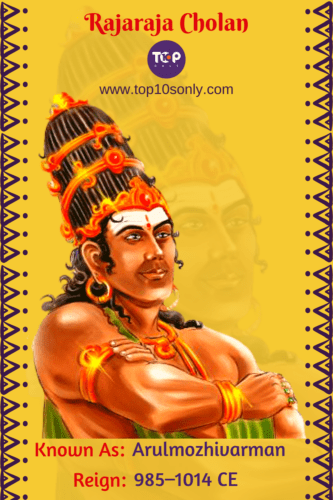
Rajaraja Cholan I
The question of who was the greatest Chola king of the ancient period gets answered with the entry of Arulmozhivarman, one of the main protagonists of Kalki’s Ponniyin Selvan books. A series of twists and turns in the line of ascension catapulted Prince Arulmozhivarman towards the helm of the Chola Empire.
As the second-born son of King Parantaka Cholan II, Arulmozhivarman was never in the running for the throne. All eyes were on the heir apparent, Aditha Karikalan Cholan, as he was expected to carry the Chola Dynasty forward into a Golden Era. However, these aspirations were dashed by his mysterious assassination and the subsequent unexpected coronation of his uncle Uttama Cholan. It has been speculated that Arulmozhivarman had temporarily forfeited the throne in a clever tactic aimed at stemming the outbreak of civil war. After the demise of Uttama Cholan, the line of ascension shifted back towards the lineage of Parantaka Cholan ll, and Arulmozhivarman was heralded as the new king of the Chola Empire in 985 CE.
Titles of Rajaraja Cholan I
As was the norm, the title of Rajakesari was adopted by Arulmozhivarman. Upon his coronation, Arumoḷi Varman was henceforth referred to by the regnal title he had adopted, Rajaraja, which literally means ‘King among Kings’. Rajaraja Cholan’s victory at the Battle of Kandalur Salai earned him the name ‘Kandalur salai kalam-arutta’ (the one who destroyed Kandalur Salai). Rajaraja Cholan I adopted the title ‘Pandya Kula Shani’ (Destroyer of the Pandya Clan) after his conquest of the Pandyas. He also adopted the title ‘Mummudi Chola’ (the Chola who Wears Three Crowns) to commemorate his rule of the Chola, Pandya, and Cheras kingdoms. Being a devout follower of the Shaivism sect, Rajaraja Cholan I was granted the title ‘Shivapada Shekhara’ (one whose crown is laid at the feet of Lord Shiva). His efforts in preserving the Tirumurai earned him another title, ‘Tirumurai Kanda Cholan’ (The Chola who saved the Tirumurai).
Highlights of The Reign of Rajaraja Cholan I
Modern-day historians have often affixed the title ‘The Great’ at the end of the name of Rajaraja Cholan. Thus, the valiant exploits of this powerful Chola king are often attributed to ‘Rajaraja Cholan I – The Great’. In effect, the ‘greatness’ of the Chola Empire began with the ascension of Rajaraja Cholan I as he was the first king to take the Chola empire across the ocean. His sharp military acumen helped create a powerful army and a strong navy. Thus, Rajaraja Cholan’s reign ensured the supremacy of the Chola Dynasty in regions as far away as the Maldive Islands in the Indian Ocean.
Battle of Kandalur Salai
One of the first crucial military conquests of Rajaraja Cholan I was that of a military academy and arsenal centre called Kandalur Salai in c. 988 CE. Historical inscriptions show that this battle was waged using the military might of both the army and the navy. Kandalur Salai is believed to have been under the control of the Ay Dynasty, who were probably feudatories of the Pandya Kingdom.
Subjugation of the Chera Perumal, Venad, and Mushika Dynasties
The conquest of Kandalur Salai paved the way for more victorious campaigns waged by Rajaraja Cholan l. One-by-one, every threat to the Chola Empire was meticulously dealt with. Inscriptions recovered in Kanyakumari and Trivandrum state that these conquests began approximately in the early 11th century. The Senur inscription, dated 1005 CE, states that Rajaraja Cholan I defeated the ‘proud rulers’ of the Venad, Mushika, and Chera Perumal Dynasties. It is believed that his son Rajendra Cholan I fought alongside him during some of these battles.
Conquest of The Pandya Kingdom
Rajaraja Cholan I continued the battle against the Pandyas. Inscriptions state that he completely destroyed the Pandya capital of Madurai and, subsequently, annexed the Pandya kingdom, which henceforth was renamed as ‘Rajaraja Pandinadu’ or, alternatively, ‘Rajaraja Mandalam’.
Conquest of Sri Lanka and Aftermath
Once Rajaraja Cholan I established his supremacy in South India, he set his eyes on another enemy kingdom- The Anuradhapura Kingdom of Sri Lanka. Rajaraja Cholan I took advantage of an internal military uprising in the Anuradhapura Kingdom that had driven Mahinda V of Anuradhapura out of his Kingdom. Using this situation to his advantage, Rajaraja Cholan I invaded the Sri Lankan kingdom and was able to annex the northern parts of Sri Lanka.
A new provincial capital called Jananatha Mangalam (referring to a title conferred previously to Rajaraja Cholan l) was established at erstwhile Polonnaruwa. A Shiva temple called Rajarajeshvara was dedicated to Rajaraja Cholan l, and it was constructed in Mahatittha, a town that was later renamed Rajarajapura to commemorate the victories of the Chola king.
Conflict With Chalukya Dynasty
During the rule of Rajaraja Cholan l, the Chola Empire faced yet another Dynasty that threatened to disrupt their expansionistic plans – the Chalukyas.
Western Chalukya Dynasty
In 973 CE, the Western Chalukyas defeated the age-old foes of the Cholas, the Rashrakutas. This brought them into direct conflict with the Cholas, who saw the Chalukya Kingdom as a rising force that had to be stopped. In 998 CE, Rajaraja conquered the regions of Gangapadi, Nolambapadi, and Tadigaipadi, which were provinces that belonged to the Western Chalukya Dynasty.
Eastern Chalukya Dynasty
Another branch of the Chalukya Dynasty, the Eastern Chalukyas, alternatively known as the Chalukyas of Vengi, also threatened the supremacy of the Cholas. The Vengi Kingdom was being ruled by the Telugu Choda King Bhima, who is believed to have taken the throne by force after killing the rightful Vengi ruler King Danarnava. Danarnava’s two sons had fled and taken refuge in the Chola kingdom. After defeating and killing King Bhima, Rajaraja Cholan I placed the eldest son of King Danarnava, Saktivarman I, on the throne of Vengi. From this point on, the Eastern Chalukya Dynasty was under the indirect control of Rajaraja Chola. To further strengthen the relations between the Cholas and the Chalukyas of Vengi, Rajaraja Cholan I married off his daughter Princess Kundavai to Vimaladitya Chalukya, the younger brother of Saktivarman I.
Conflict With Hoysala Dynasty
The Hoysalas were allies of the Western Chalukyas and were also an emerging threat to the Chola Dynasty. As per an inscription at the Gopalakrishna temple at Narasipur, in 1006 CE, Rajaraja Cholan’s general Aprameya is believed to have killed a Hoysala minister named Naganna along with other generals. A similar inscription in Channapatna is believed to depict Rajaraja Cholan I defeating the Hoysalas.
Naval Expedition to Lakshadweep and The Maldives
What better way to showcase the power of the navy than by mounting an expedition to capture far-off islands like Lakshadweep and the Maldives! One of the last conquests of Rajaraja Cholan I was the naval conquest of the islands of Maldives, specifically the Thiladhunmadulu atoll, and parts of the northernmost islands of the Maldives.
Administration of Rajaraja Cholan I
Apart from being an astute military commander, Rajaraja Cholan I was an efficient administrator. He was instrumental in the reorganisation of the whole kingdom into administrative units called valanadus, which was achieved through a comprehensive land survey and assessment project undertaken in 1000 CE. Rajaraja Cholan I is credited with establishing an audit system that promoted accountability in public bodies and also adopted several measures to strengthen local self-government.
Rajaraja Cholan’s elder sister Kundavai Pirattiyar is believed to have been truly a remarkable and inspiring woman and was a source of many innovative policies initiated during his reign. She was married to one of his chief commanders, Vallavaraiyan Vanthiyathevan, and is believed to have assisted him in the administration and management of temples. In 1010 CE, Rajaraja built the architectural wonder, the Brihadisvara Temple (also known as Brihadeeswara Temple, Thanjai Periya Kovil, Peruvudaiyar Kovil, Rajarajeswara Temple, and Rajarajeswaram) in Thanjavur. This temple is one of the largest temples in India and is a part of the UNESCO World Heritage Site known as the Great Living Chola Temples.
One of the greatest achievements of Rajaraja Cholan I is the compilation and preservation of the Thirumurai, a compendium of hymns created by great Tamil poets Appar, Sambandar and Sundarar.
Personal Life of Rajaraja Cholan I
Rajaraja Cholan I had several Queen consorts, the notable ones being Thiripuvana Madeviyar, Lokamahadevi, Cholamahadevi, Prithivimahadevi, etc. He is said to have had two sons, Rajendra Cholan I and Araiyan Rajarajan, as well as three daughters, Rajarajan Kundhavi Alvar, Arulmozhi Chandramalli (also called Gangamadevi), and Mathevadigal. Rajendra Cholan I was made co-regent of the Chola Empire towards the last few years of Rajaraja Cholan’s reign.
Rajaraja Cholan I passed away in 1014 CE.
Depiction of Rajaraja Cholan I In Popular Culture
Being one of the most famous kings of the Chola dynasty, Rajaraja Cholan I has been depicted in several literary and visual works. The most notable ones are:
Literary Works
In Kalki Krishnamurthy’s Ponniyin Selvan novels. Arulmozhivarman/Rajaraja Cholan I is one of the main protagonists of the book series, along with Vallavaraiyan Vanthiyathevan, who subsequently marries Rajaraja Cholan’s elder sister Kundavai Pirattiyar.
Tamil author Balakumaran’s book Udayaar depicts Rajaraja Cholan’s decline and Rajendra Chola I’s ascension.
Movies
Sivaji Ganesan plays the titular role in the 1973 Tamil film Raja Raja Chozhan.
Audiences were able to see the legendary prince Arulmozhivarman in the Ponniyin Selvan 1 movie released in 2022. Actor Jayam Ravi portrays this role, while actors Trisha and Karthi play the roles of Ilaiya Piratti Kundavai Devi and Vallavaraiyan Vanthiyathevan, respectively.
Predecessor:
Uttama Cholan

Rajaraja Cholan l
Successor:
Rajendra Cholan l
8. Rajendra Cholan I (1014 CE – 1044 CE)
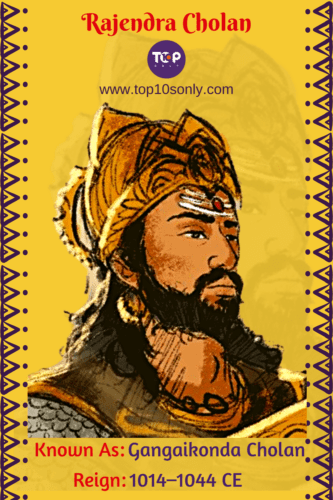
Rajendra Cholan I
The greatness of the Chola Empire did not cease with the demise of Emperor Rajaraja Cholan I – The Great. In fact, the Chola Empire continued to expand and thrive under the reign of his successor, his eldest son Rajendra Cholan l. The Chola empire’s wealth grew considerably with the many conquests achieved by this most famous Chola king.
As per historical records, Rajendra Cholan I was born in Thanjavur, presumably in 971 CE. He was a valiant young prince of the Chola Empire, having fought alongside his father, Rajaraja Cholan l, during the conquest of the Western Chalukya, Chera, and Pandya dynasties, as well as in the wars against the Sri Lankan rulers of Anuradhapura. Before ascending the throne in 1014 CE, Rajendra Cholan I is also believed to have ruled the Chola Kingdom as a co-regent. His reign ushered in the most splendid period of the Cholas. Rajendra Cholan I is credited with expanding the Chola Empire to its greatest extent, thereby enabling it to dominate the trade routes in the Indian Ocean.
Titles of Rajendra Cholan I
Rajendra Cholan I was conferred with the traditionally alternating title of Parakesari. He gathered several more titles, with each achievement made during his reign. From his father, he inherited the title Mummudi Cholan. His several conquests earned him the titles Gangaikonda Cholan, Kadaram Kondan, Mudigonda Cholan, and Irattapadikonda Cholan. Rajendra Cholan I also adopted the title Chalukya-Chudamani (Crest Jewel of the Chalukyas).
Highlights of The Reign of Rajendra Cholan I
The glorious era of the Chola Dynasty was carried forward by the expansionistic policies of Rajendra Cholan l. Under his powerful reign, the military and naval prestige of the Chola Empire reached its zenith of prosperity, and this was because he took the Cholan Empire across the ocean. Rajendra Cholan I holds the distinction of being one of the few Indian rulers to successfully colonize domains outside the Indian subcontinent.
Battle of Maski
One of the earliest decisions of King Rajendra Cholan I was to tackle the increasing influence of the Western Chalukyan monarch Jayasimha II, who had begun interfering in the ascension of the Chola patronage-enjoying Eastern Chalukyan Dynasty. This led to the Battle of Maski (1019 CE – 1020 CE). After defeating Jayasimha II, Rajendra Cholan established Rajaraja Narendra, the son of Chola princess Kundavai and former Eastern Chakulya King Vimaladitya, as the King of the Vengi kingdom of the Eastern Chalukyas.
Conquest of Anuradhapura and Aftermath
The Cholas continued their onslaught on the Sri Lankan Kingdom of Anuradhapura. By the fifth year of his reign, in approximately 1018 CE, Rajendra Cholan I is believed to have conquered the entire island of Sri Lanka, merging the whole Kingdom of Anuradhapura with the Chola Empire. The Sinhalese historical chronicle Mahavamsa gives graphic details of this campaign. Rajendra Cholan I is believed to have fulfilled the wishes of his ancestor Parantaka Cholan I by ultimately capturing the crown jewels along with the Royal family of Anuradhapura. Sinhala king Mahinda V was deported to the Chola Kingdom, where he died after twelve years of imprisonment.
Prince Kassapa, the fugitive son of Mahinda V, proclaimed himself as the new monarch of Anuradhapura, and he set about organising revolts against the Chola Empire. However, it didn’t really create much of a dent in the Chola rule in Sri Lanka, and his death in 1040 effectively ended the uprisings.
Expedition To North India
Following his success in restoring the balance of power in the Vengi Kingdom, Rajendra Cholan set his sights on the northern kingdoms. Between 1019 CE and 1024 CE, a series of expeditions were made by the Chola army, led by Rajendra Cholan l, to conquer the lands that lay between the Chola Kingdom and the River Ganga. These were the realms of Kalinga, Odda (Odisha), Madhya Pradesh, Jharkhand, Uttar Pradesh, Bihar, and Bengal.
In approximately 1019 CE, the Chola army marched into Kalinga, conquered the Somavamsi Kingdom, and overthrew King Indraratha. From there, they steadily marched forward to Bengal, the land of the Pala Dynasty, and dethroned King Mahipala. Even the Kamboja-Pala Kingdom was toppled by the onslaught of the Chola army. The Cholas are also credited with the decimation of the Buddhist Kingdom of the Chandra Dynasty that ruled the Samatata region of Bengal.
The northern expedition of Rajendra Cholan I culminated on the banks of the River Ganga. To commemorate this event, Rajendra Cholan I assumed the name of Gangaikonda Cholan (The Chola who conquered the River Ganga).
Campaign To Southeast Asia
The immensely successful campaigns of Rajendra Cholan I gave him the impetus to look beyond the Indian Subcontinent. Thus started one of the most exciting periods in the history of the Cholas – Rajendra Cholan’s naval expedition to Southeast Asia!
Srivijaya
Governed by the Sailendra dynasty, Srivijaya was a maritime empire, with its capital city in Palembang on the island of Sumatra (in modern-day Indonesia). The Chola dynasty launched naval raids on the ports of Srivijaya in 1025 CE.
Historians have a number of theories as to what prompted these attacks. One of the theories is that the Chola Dynasty had ties with the predominantly Hindu Khmer Empire of Cambodia, ruled by King Suryavarman I. The Khmer Empire formed an alliance with the Cholas to conquer the Buddhist Kingdom of Tambralinga. To guard themselves against this onslaught, the Tambralinga Kingdom formed an alliance with the Srivijaya Kingdom, thus prompting Rajendra Cholan I to launch an assault against them.
The Srivijaya Kingdom was totally unprepared for the onslaught that followed, and the capital Palembang fell swiftly. As per the Thanjavur inscription, King Sangrama Vijayottunggavarman of Srivijaya was taken captive by the Cholas. The inscription also mentions the Cholas discovering bountiful treasures, including the Vidhyadara Torana, the fabled ‘bejewelled gate’ of the Srivijaya Kingdom.
Kadaram
Another notable conquest of Rajendra Cholan was that of the Bujang Valley in present-day Kedah province in Malaysia. Historically known as Kadaram, it is believed to have been under the protection of the Srivijaya Kingdom. However, due to the downfall of the Srivijaya Kingdom, the forces of Rajendra Cholan I were able to easily conquer Kadaram. This conquest earned Rajendra Cholan I the title ‘Kadaram Kondan’ (Conquerer of Kadaram/Kedah).
Other Conquests In South East Asia.
Many other regions in South East Asia fell under Rajendra Cholan’s military prowess. Pannai in Sumatra, Malaiyur (believed to be either in Indonesia or in the southern part of the Malay Peninsula), Ilangasoka or Langkasuka ( believed to be located in the eastern part of the Malay Peninsula), Talaittakkolam ( possibly in Thailand), Mayirudingam (central part of the Malay Peninsula), Mapappalam (Lower Burma), Nakkavaram (believed to be the Nicobar Islands).
Historians believe that the South East expedition was not meant to bring about any long-term occupation of those realms but was rather a means to showcase the colossal power of the Cholas. This expedition had several lasting effects. The Chola Empire maintained strong diplomatic relations with the Khmer Kingdom of Cambodia due to the support given during the onslaught against the Kingdoms of Tambralinga and Srivijaya. Due to the weakening of the Srivijaya Kingdom, the Cholas gained control of the Strait of Malacca, subsequently leading to improved commercial relations with various kingdoms, like the Song Dynasty of China. By sending several diplomatic delegations, Rajendra Chola I was able to establish stronger relations with China.
The exploits of the Cholas are described in the ancient Malay book Sejarah Melayu, and Rajendra Cholan’s name is mentioned erroneously as Raja Chulan. The legacy of the Cholas has continued in certain places. For instance, a few Malaysian princes bear names appended with the title or surnames Cholan, Chola or, alternatively, Chulan. One notable example is the late Raja Chulan from the Malayasian Perak Royal Family.
Administration of Rajendra Cholan I
Rajendra Cholan I is undoubtedly the most powerful monarch of the Chola Dynasty. Under his reign, the Cholas reached the pinnacle of success. Rajendra Cholan I was an able ruler, with his administrative skills matching the prowess with which he had commanded the Chola military and navy.
Gangaikondacholapuram
The successful campaigns of Rajendra Cholan I in the north were commemorated with the founding of a new capital city – Gangaikondacholapuram. Gangaikondacholapuram is the amalgamation of four words – Gangai (River Ganga)/ Konda (conquered)/ Chola (Chola)/ Puram (City). Gangaikondacholapuram served as the capital of the Chola Empire for around 250 years and was the site of the coronations of several successive Chola Kings.
Rajendra Cholan I is said to have commissioned a marvellous multi-storied royal palace to be built at Gangaikondacholapuram using burnt bricks. Not much has survived the passage of time, the exception being a few pillar bases made of granite.
The Thiruvalangadu plates credit the creation of the Cholaganga tank to Rajendra Cholan I. The inscription asserts that Rajendra Cholan I, to commemorate his victory over the Pala Dynasty, erected a Ganga-jalamayam jayasthambham, or a ‘liquid pillar of victory’, in the capital city of Gangaikondacholapuram.
The wealth and prosperity of the Chola Empire rose dramatically during the reign of Rajendra Cholan. Trade flourished thanks to the extraordinary far-sightedness and determination of Rajendra Cholan. The Cholas are believed to have undertaken spice trade with Arabian, North African, and Anatolian traders. Chinese vessels were incorporated into the Chola military after establishing crucial commercial ties with China.
Temples
Emulating his glorious ancestors, Rajendra Cholan I constructed and renovated several temples. A new temple called Gangaikonda Choleeswarar Temple, which was similar to the Brihadeeswarar Temple at Thanjavur was constructed in the newly-created city of Gangaikondacholapuram. He also expanded the Koneswaram temple and the Pathirakali Amman Temple in Trincomalee, Sri Lanka.
Personal Life of Rajendra Cholan I
Rajendra Cholan I had several consorts, the notable ones being Tribhuvana (Vanavan Mahadevi), Panchavan Mahadevi, Mukkokilan Adigal and Viramahadevi. Rajendra Cholan is also believed to have married Puteri Onangki (Onang Kiu), the daughter of King Sangrama Vijayottunggavarman, after his conquest of the Srivijaya Kingdom of Sumatra.
The seven sons of Rajendra Cholan I were Rajarajan Cholan, Rajadhiraja Cholan, Manukula Kesari Cholan, Sanga Varman Cholan (also known as Sangavarman Lankeshwaran), Rajendra Cholan II, Rajamahendran Cholan, and Virarajendra Cholan. The eldest son Rajarajan Cholan is believed to have been a child when he died, resulting in Rajadhiraja Cholan I becoming the heir apparent. It is possible that Manukula Kesari Cholan and Rajamahendran Cholan died while battling the enemies of the Chola Empire. Inscriptions mention Sanga Varman Cholan as being declared as the governor of Sri Lanka and adopting the title ‘Sangavarman Lankeshwaran’.
Rajendra Cholan I had two daughters, Princess Ammangadevi and Princess Arulmoli Nangaiyar Piranar. To further strengthen the alliance of the Cholas and the Eastern Chalukyas, Rajendra Cholan I married off his daughter, the Chola princess Ammangadevi, to the monarch of the Vengi Kingdom, Rajaraja Narendra. Their offspring would become yet another remarkable Chola Emperor, Kulottunga l.
Rajendra Cholan I passed away in 1044 AD. His wife Viramahadevi is reported to have committed sati upon her husband’s death.
Depiction of Rajendra Cholan I In Popular Culture
In 1972, India’s newest merchant navy training ship was commissioned. It was named TS Rajendra to commemorate the fantastic naval exploits of Rajendra Cholan I.
Rajendra Cholan I has been depicted in several literary works. He is the protagonist in Vembu Vikiraman’s Gangapuri Kavalan. The famous historical novel Vengayin Maindhan by Sahitya Academy Award winner Akilan covers the life and achievements of Rajendra Chola I and is sometimes considered a sequel to the Ponniyin Selvan novels.
Predecessor:
Rajaraja Cholan l

Rajendra Cholan l
Successor:
Rajadhiraja Cholan l
9. Rajadhiraja Cholan I (1044 CE – 1052 CE)
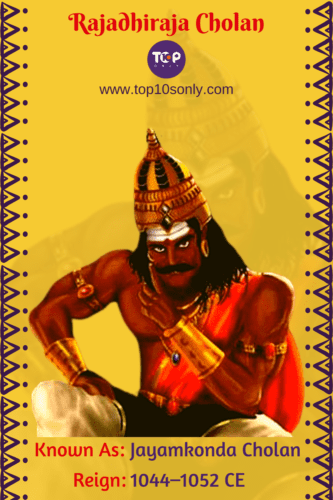
Rajadhiraja Cholan I
After the demise of the illustrious Chola Emperor, Rajendra Cholan l, the crown was passed on to Rajadhiraja Cholan l, whose name literally means ‘The King of Kings’ or the ‘The greatest of all Kings’. By being made co-regent during the reign of his father, Rajadhiraja Cholan I had been groomed from a young age to take over the reins of the Chola Empire. With the coronation of this incredibly skilled military commander, the Chola Empire appeared all set to overtake the extraordinary achievements made by the preceding Chola Kings.
However, fate had decided to take a hitherto unprecedented path, and in less than ten years, the Chola Empire would be witness to the unexpected coronation of the next ruler of the Cholas!
Rajadhiraja Cholan I was born in 994 C.E., in Thanjavur, as the second son of Rajendra Cholan I and his queen consort Mukkokilan Adigal. The early demise of the eldest prince, Rajarajan Cholan, led to Rajadhiraja Cholan I being declared the heir apparent. In 1018 CE, during the early years of the reign of Rajendra Cholan l, Rajadhiraja Cholan I was proclaimed as co-regent of the Chola Empire. During his years as co-regent, Rajadhiraja Cholan I proved himself a worthy heir to the throne. He was often at the frontlines of the wars waged by the Cholas against the Pandyas and the Western Chalukyas.
Unfortunately, it was this fearlessness that set about a hitherto unprecedented tragic event in the history of the Chola Empire.
Titles of Rajadhiraja Cholan I
Apart from the traditional ‘Rajakesari’ title, Rajadhiraja Cholan I had several other honorary titles. His exceptional military prowess earned him the title ‘Jayamkonda Cholan’ (The Victorious Chola). His campaigns against the Western Chalukya Dynasty earned him titles like ‘Kalyanapuramgonda Cholan’ (Conquerer of Western Chalukyan capital Kalyanapuram), ‘Ahavamally Kulantaka’ (possibly a reference to Western Chalukya King Someshvara I who was also known as Ahavamalla), and ‘Vijaya Rajendra Cholan’ (the victorious Rajendra Cholan) after performing the Virabhisheka or Ashvamedha ritual. He is believed to have also adopted the name ‘Virarajendra Varman’.
Highlights of The Reign of Rajadhiraja Cholan I
The short reign of Rajadhiraja Cholan saw several conflicts. Rajadhiraja Cholan was a warrior through and through. Being proficient in the art of war, Rajadhiraja Cholan would personally command his armies and was a prominent presence on the frontlines of his campaigns.
Revolts in Sri Lanka
After the demise of the captive Sinhalese King Mahinda V, his son Prince Kassapa (also known as King Kassapa VI and Vikramabahu) became a prominent leader in the Sri Lankan revolt against the Cholas. He became the self-proclaimed monarch of Sri Lanka and launched several deadly attacks against the Chola army, the most notable one being the massacre of the Chola garrisons in the Sri Lankan province of Ruhuna. The Sri Lankan resistance was reportedly aided by the age-old nemesis of the Cholas – The Pandya Dynasty. However, the revolts were weakened with the mysterious death of Kassapa VI in 1040 CE. Rajadhiraja I is believed to have quelled the revolts by having the Pandya prince Vikarama Pandya and his ally, a Kanauj prince called Jagatpala, killed in battle.
Battle of Dannada and Aftermath
The Cholas had succeeded in maintaining strong relations with the Eastern Chalukyas, primarily through marital alliances. The rival Western Chalukyas had long viewed this alliance with immense displeasure, and their newly coronated monarch, King Someshvara I (Ahavamalla), sought to put an end to it. A short, unsuccessful invasion of Vengi followed, with the Western Chalukyan army retreating back to their kingdom after being thoroughly defeated by the Chola army. Perhaps fuelled by the success of this attack, the Cholas pursued their enemy and invaded the territories of the Western Chalukyas.
King Rajadhiraja Cholan I defeated Someshvara I in the Battle of Dannada on the banks of the Krishna river. A series of victories followed, and the Western Chalukyan territories of Kollipakkai, Yetagiri, Kampilli, and Pundur fell one by one, unable to withstand the might of the Chola army. The climax of this campaign was at the Western Chalukyan capital of Kalyanapuram, which was totally destroyed by Rajadhiraja Cholan’s army in c.1045 CE.
However, this victory was short-lived. Around 1050 CE, Someshvara I was able to gather his forces and was once again attempting to exert his dominance.
Tragedy At The Battle of Koppam
Someshvara I’s growing influence did not fail to escape the notice of Rajadhiraja Cholan l. With his newly appointed co-regent, his younger brother Rajendra Cholan II, Rajadhiraja Cholan I launched an attack in 1054 to counter the Western Chalukyas. The invasion began with the destruction of the Rattamandalam province. Emboldened by their gain, the Chola army, led personally by Rajadhiraja Cholan I from atop his war elephant, pressed forward. To counter their advance, Someshvara I mustered his army, and the two opposing sides met at a place called Koppam. A fierce battle ensued, and the Cholas had the upper hand.
Unfortunately, in the heat of the battle, the supreme commander of the Chola forces, Rajadhiraja Cholan l, was shot dead by Western Chalukyan archers. Thus, Rajadhiraja Cholan I was the first emperor in the history of the Cholas to be killed on the battlefield. His tragic demise earned him the epithet ‘Yaanai mel thunjiya thevar’ (the king who died on the back of an elephant). Rajendra Cholan II was proclaimed the new monarch on the battlefield, and he was able to successfully rally the Cholas against the Western Chalukya army of Someshvara I.
Administration of Rajadhiraja Cholan I
Not much is known about the internal state of affairs of the Chola Kingdom during the reign of Rajadhiraja Cholan l. However, the Manimangalam inscriptions state that Rajadhiraja Cholan I appointed several of his relatives to important administrative positions, and some were even made governors or subordinate rulers of the conquered lands.
Recently, the remnants of a Shiva temple, believed to have been commissioned by Rajadhiraja Cholan l, were discovered at Gangenahalli in the Tumkur district of Karnataka. An ancient stone inscription states that the temple was built to commemorate the reign of Rajendra Cholan l.
Personal Life of Rajadhiraja Cholan I
The queens of Rajadhiraja Cholan I have not been named, but historians have found references to ‘Trailokyamahadevi’, or alternatively, ‘Trilokyam Udaiyar’, titles assumed by Queens of the Chola Kings. Rajadhiraja Cholan I is believed to have fathered two sons, Madhurandhagan and Kandaradithan. However, for unknown reasons, they have not been included in the line of ascension.
Predecessor:
Rajendra Cholan l

Rajadhiraja Cholan l
Successor:
Rajendra Cholan ll
10. Virarajendra Cholan (1065 CE –1070 CE)
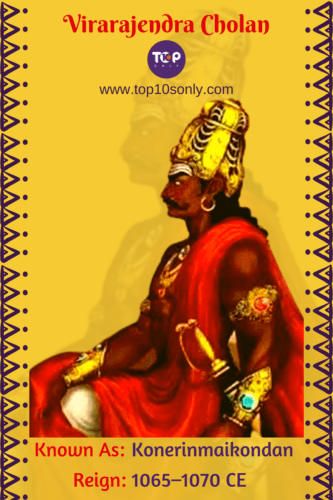
Virarajendra Cholan
The Chola line of ascension was witness to many unexpected twists and turns, and at times the unlikeliest of heirs could be seen ascending the throne. The youngest-born son is seldom likely to be crowned king. However, the Chola Empire saw Virarajendra Cholan, presumably the seventh child of King Rajendra Cholan I, coronated as the next monarch after the demise of his elder brother King Rajendra Cholan II. The reign of Virarajendra Cholan is often considered to be the prelude to the end of the era of the Medieval Cholas, and many believe him to be the last of the great Chola Kings of this period.
Virarajendra Cholan was born in 1002 C.E. in the city of Thanjavur to Queen Mukkokilan Adigal, the mother of the previous two monarchs. Several inscriptions mention Virarajendra Cholan as a strong supporter of his father, Rajendra Cholan I, and his brothers, Rajadhiraja Cholan I and Rajendra Cholan II, during their reign of the Chola Empire. During his early years, Virarajendra Cholan is believed to have been appointed by King Rajadhiraja Cholan I as the Chola viceroy of Sri Lanka. He also served as the Lord of Uraiyur during the reign of Rajendra Cholan II.
With years of guidance from his illustrious father and elder brothers, along with the valuable skills gained from handling such important administrative positions, Virarajendra Cholan was more than ready to take on the responsibility of being the next Emperor of the Cholas!
Titles of Virarajendra Cholan
Virarajendra Cholan was granted the alternating traditional title of ‘Rajakesarivarman’. His elder brother, the former monarch Rajendra Cholan ll, is believed to have granted him the title ‘Karikala Cholan’. An ancient inscription found at Tirunamanallur states that Virarajendra Cholan had several titles, such as Maharajadhiraja Cholakula-Sundara, Sri-Virarajendradeva, Pandyakulantaka, Srimedinivallabha, Konerinmaikondan, Ahavamallanai-mummadi-ven-kanda Rajasraya, Ahavamallakula-Kala, Rajakesarivarma Perumanadigal and Sakalabhuvanasraya.
Highlights of The Reign of Virarajendra Cholan
By the time Virarajendra Cholan ascended the throne, the Chola Empire had already acquired the reputation of being a military, economic and cultural powerhouse, not just in the Indian Subcontinent but also in the far-off lands of South-East Asia. The Cholas had two objectives – one was to keep expanding their dominion, while the other was to safeguard all the realms that they had gained. Despite the brief span of his reign, Virarajendra Cholan succeeded in achieving both of these objectives. However, the quick succession of the three kings in the Chola Empire did not go unnoticed, and the enemies of the Cholas sought to take advantage of the resultant confusion.
Conflicts in Pandya, Chera Perumal and Pottapi Kingdoms
One of the earliest issues that faced Virarajendra Cholan was the outbreak of a spurt of rebellions, notably in the Chola-ruled Pandya territories and Chera Perumal regions. Virarajendra waged campaigns to quell these rebellions. He battled and killed the kings of the Pottapi and Chera Perumal Kingdoms and suppressed the rebellious Pandya princes.
The Western Chalukya Wars
The Western Chalukya Dynasty was a cause of ceaseless concern for the Cholas. The conflicts against the Western Chalukya Dynasty had begun long before Virarajendra Cholan became the monarch. The rebellions in various Chola-controlled regions gave the Western Chalukya Kingdom the opportunity they had long awaited, a chance to successfully invade the Chola Empire. Using Virarajendra Cholan’s absence to their advantage, the Western Chalukya ruler Someshvara I invaded the Chola Kingdom. He assigned his son Vikramaditya VI the task of conquering the Chola capital Gangaikondacholapuram. This brief victory was short-lived, for they were routed out of the Chola Empire by Virarajendra Cholan when he returned from his battles.
Virarajendra Cholan waged a counter-attack against the Western Chalukyan army and led the Chola forces to the Chalukyan capital of Kalyanpura. Someshvara I was defeated and is believed to have run away from the battlefield.
Someshvara I was relentless in his pursuit of supremacy, despite having incurred heavy losses in each battle with the Chola forces. His cities were destroyed, his generals were beheaded, and his sons were humiliated. To put an end to this, Someshvara I challenged Virarajendra Cholan to a final battle at Kudalsangamam in 1067 C.E. However, this battle never took place as the Western Chalukya forces never showed up! After waiting for around a month, Virarajendra Cholan led his army into Chalukya territory and began a wave of destruction. A victory pillar was erected by the Cholas near the Tungabhadra River to commemorate their success. Someshvara I is believed to have committed ritual suicide soon after by drowning himself in the Tungabhadra river at Kuruvatti.
Someshvara Il, the eldest son of Someshvara I, was coronated as the new king of the Western Chalukyan Dynasty. This went against the wishes of his ambitious younger brother Vikramaditya VI, who had been eyeing the throne for himself. In a clever tactic to usurp the throne, Vikramaditya VI allied himself with the Chola monarch Virarajendra Cholan, bringing about a partial resolution of the Western Chalukyan conflict.
Conquest Of Vengi
The Cholas successfully re-established their influence in the Kingdom of the Eastern Chalukyas at Vengi. The Western Chalukya Kingdom had tried to wrest the power from the hands of the Cholas by crowning a puppet ruler who would be controlled by them. However, these plans never came to fruition as Virarajendra’s armies successfully drove out the Western Chalukyan forces stationed at Vengi.
Conflict In Sri Lanka
Virarajendra Cholan’s reign saw the rise of a new rebel leader in Sri Lanka. The historical chronicle Mahavamsa states that Vijayabahu I, believed to be a descendant of the Sinhalese Royal Family, had been able to create a stronghold in the Ruhuna district. Using this strategic position, he launched attacks to destabilise the Chola control of Sri Lanka. To quell these attacks, Virarajendra Cholan ordered the Chola troops posted in Sri Lanka to attack Vijayabahu’s base in Ruhuna. He even sent reinforcements from the mainland to support his forces on the island.
Campaign Against Kadaram (Kedah)
The Chola’s influence in South East Asia is legendary. Rajendra Cholan I had undertaken successful campaigns against the kingdoms of Kadaram (Malaysia) and Srivijaya (Indonesia). During Virarajendra Cholan’s reign, it is believed that a prince/king from these lands had approached him for help in reclaiming Kadaram in approximately 1068 CE. Virarajendra Cholan presumably launched a naval campaign and seized back control of Kadaram.
Administration of Virarajendra Cholan
Virarajendra Chola’s reign may have been brief, but it was glorious nevertheless. Truly a great leader, Virarajendra Cholan is known to have had the best interests of his people at heart. Inscriptions discovered at the Sri Appan Venkatesa Perumal Temple in Thirumukkoodal, Tamil Nadu, mention a Veda Patasala (Vedic School) and an Athura Saalai (medical centre) that was under the patronage of Virarajendra Chola.
The Vedic school is believed to have offered around eight subjects, including grammar, Vedas, Shastras, etc. The inscription mentions the number of students and teachers and the remuneration paid to the staff. There is also mention of a hostel for the students.
The hospital, named ‘Virasolan’ or ‘Veera Chozhan’, was presumably attached to this Vedic school. Its primary objective was to treat the afflictions of the students and their teachers. Equipped to handle fifteen patients at a time, this hospital was well-staffed and stocked several varieties of herbal medications.
Personal Life of Virarajendra Cholan
As per the inscriptions found in the Brihadeeswarar temple in Thanjavur, Virarajendra Cholan’s queen was Arumolinangai. He is believed to have had at least three children. The eldest was his successor Athirajendra Cholan. His younger son Gangaikondachola was presumably appointed as the viceroy of the Chola-controlled Pandya Kingdom. As regards his daughter, Chola princess Rajasundari, there are two theories regarding her fate. To permanently strengthen the alliance between the Cholas and the Western Chalukyas, Virarajendra Cholan is believed to have offered his daughter’s hand in marriage to the Western Chaluyan King Vikramaditya VI. Alternatively, Virarajendra Cholan is thought to have married off his daughter Rajasundari to Rajaraja Deva, the ruler of the Kalinga kingdom, and their child Anantavarman Chodaganga Deva is considered to be the founder of the Eastern Ganga Dynasty.
The brief but triumphant reign of Virarajendra Cholan came to an end in 1070 CE. After his demise, his eldest son, prince Athirajendra Cholan, ascended the throne, and with his death, the illustrious lineage of Vijayalaya Cholan came to an end. However, historians agree that Virarajendra Cholan was truly the last of the great Imperial Cholas.
Predecessor:
Rajendra Cholan II

Virarajendra Cholan
Successor:
Athirajendra Cholan
The Chola Empire: India At Its Peak
At the height of their power, the Cholas were a formidable force to be reckoned with, be it on land or at sea. During this Golden Age, the Chola kingdom was massive, perhaps more vast than it had ever been. The great Chola kings conquered peninsular India and even led successful expeditions up north, through regions in Uttar Pradesh, Orissa, Bihar, Madhya Pradesh, Jharkhand and Bengal, till they reached the Ganga river. The Chola civilisation was not confined within the borders of modern India. The most powerful rulers of the Chola dynasty took the empire across the ocean, away from the Indian Subcontinent. Regions in the Lakshadweep and Nicobar Islands, Srilanka, Maldives, and even Southeast Asian countries like Malaysia, Indonesia and Southern Thailand came under the control of the Cholan Empire.
There have been significant contributions to the fields of religion and literature from all the major Chola Kings. The Cholas excelled in every aspect of public administration, be it public works, infrastructure, or defence. Perhaps the leaders of today can learn a lesson or two from these great kings of the past!
With this, we come to the end of this fantastic journey spanning over two and a half centuries that are even today remembered as ‘The Golden Age Of The Chola Empire’.
Let us know in the comments what you think of these Top 10 Greatest Chola Kings Of Ancient India.

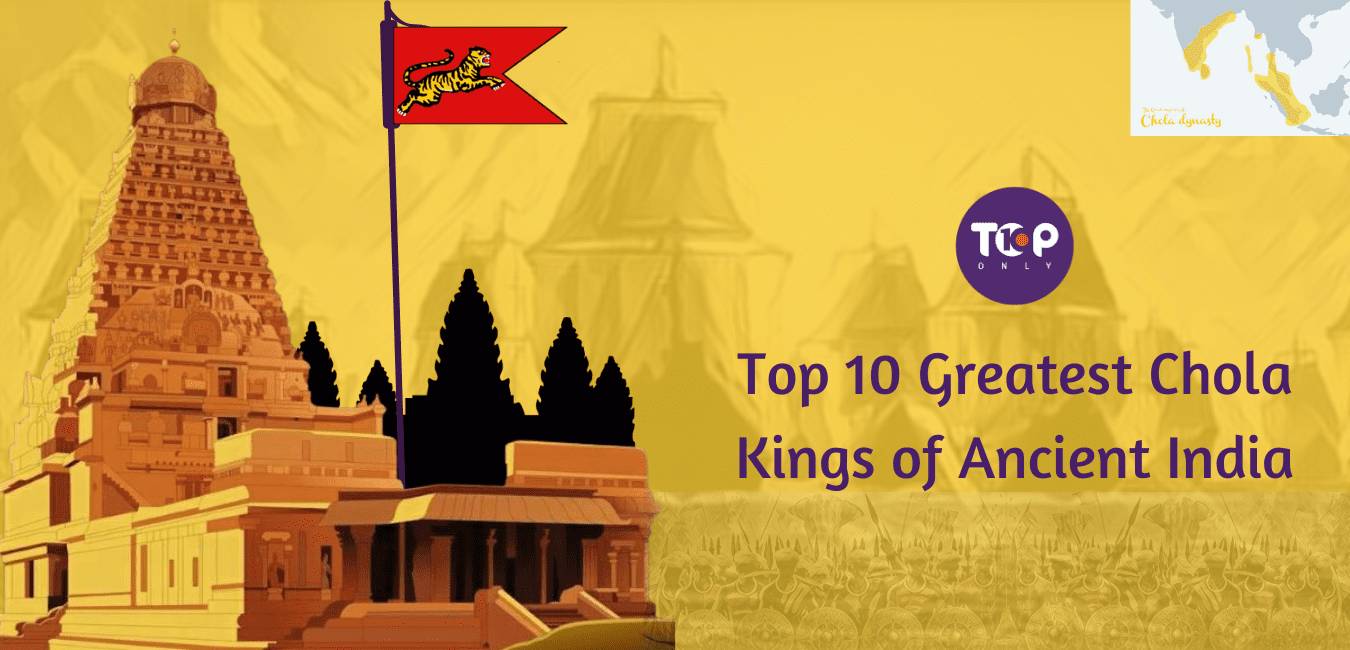
Pingback:Top 10 Best Aishwarya Rai Bachchan Movies | Top 10s Only
Pingback:Top 10 Places To Visit In Trichy, Tamil Nadu | Top 10s Only
Pingback:Top 10 Best Temple Hills Near Bangalore In Karnataka For A Day Trip | Top 10s Only
Pingback:Top 10 Interesting Facts King Parantaka II | Sundara Cholan | Top10sOnly
Pingback:Top 10 Best Places To Visit In And Around Kolli Hills | Top 10s Only
Pingback:Top 10 Interesting Facts About Crown Prince/Co-regent Aditha Karikalan Cholan (966 CE – 971 CE) | Top 10s Only
Pingback:Top 10 Interesting Facts About King Rajaraja Cholan I aka Arulmozhivarman (985 CE – 1014 CE) | Top 10s Only
Pingback:Top 10 Best Movies of South Indian Actor Jayam Ravi | Top 10s Only
Pingback:Top 10 Best Movies of South Indian Actor Vikram | Top 10s Only
Pingback:Top 10 Best Movies Of South Indian Actor Karthik Sivakumar aka Karthi | Top 10s Only
Pingback:Top 10 Facts | Vallavaraiyan Vanthiyadevan | Top10sOnly
Pingback:Top 10 Interesting Facts About King Rajendra Cholan I (1014 CE – 1044 CE) | Top 10s Only
Pingback:Top 10 Interesting Facts | King Uttama Cholan | 980 CE – 985 CE | Top 10s Only
Pingback:Top 10 Interesting Facts | Princess Kundavai | Chola Empire | Top 10s Only
Pingback:Top 10 Most Magnificent Royal Palaces Of India | Top 10s Only
Pingback:Top 10 Must-Visit Palaces Of South India | Top 10s Only
Pingback:Top 10 Popular Friendships In Indian History That Defied Boundaries